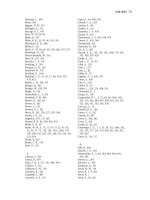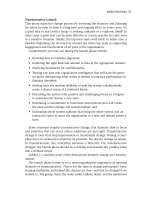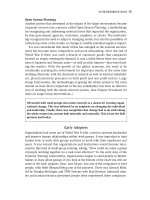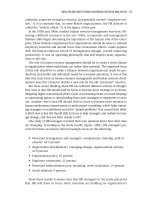Practicing Organization Development (A guide for Consultants) - Part 4 pot
Bạn đang xem bản rút gọn của tài liệu. Xem và tải ngay bản đầy đủ của tài liệu tại đây (229.44 KB, 10 trang )
Introduction
Getting the Most from This Resource
William J. Rothwell and Roland L. Sullivan
T
he paradox of our time is that change has become the only constant. And,
indeed, the rate of change itself has also changed, with some experts sug-
gesting that the rate of change—and the body of human knowledge—is
doubling every ten years (Colteryahn & Davis, 2004). Changes occur in organi-
zations every day. Organizations are started, and some evolve while others
dissolve. Some undergo mergers, takeovers, or buyouts; some go bankrupt.
Changes in corporate ownership may result in corporate rightsizing, down-
sizing, early retirement offers, or various other staffing alterations. To cope with
the fierce competition organizations face, senior managers are taking innova-
tive steps by introducing many change efforts.
Practicing Organization Development: A Guide for Consultants (2nd ed.) is
about facilitating these and other organizational changes. But this book is not
about just any type of organizational change; rather, it focuses on planned, sys-
tematic, and educationally oriented change that is carried out for organizational
improvement. The book is about organization development (OD). Organization
development may be defined as “a system-wide application of behavioral science
knowledge to the planned development, improvement, and reinforcement of
the strategies, structures, and processes that lead to organization effectiveness”
(Cummings & Worley, 2005, p. 1).
Although the book addresses organizational change, many principles
described in it also apply to change efforts with individuals, with teams, or
across organizations.
1
∂
∂
04_962384 intro.qxd 2/3/05 12:02 AM Page 1
THE AUDIENCE FOR THE BOOK
This book has three intended audiences: internal and external OD consultants,
workplace learning and performance professionals, and managers and executives.
The primary audience is OD consultants. There are two levels of OD consul-
tants: practitioners and master practitioners. This book is geared to practition-
ers, those who are already carrying out the role of change agent but need more
formal grounding in organization development theory and practice. This
includes students enrolled in courses on OD, organizational behavior, or orga-
nizational change. Master practitioners may also find this book useful as a guide
to OD literature and as a tool to help them orient, train, and mentor other OD
consultants.
Our second audience is workplace learning and performance (WLP) practi-
tioners, previously called human resource development (HRD) practitioners. Some
WLP practitioners specifically train employees. They devote their attention largely
to increasing employees’ job knowledge and to improving individual performance
in organizational settings. But many WLP practitioners go beyond training to
ensure that identified training needs take organizational and work-group cultures
into account. In addition, results-oriented WLP practitioners are aware that indi-
vidual performance improvement can only occur when the surrounding work
environment supports it. The theory and practice of changing organizational and
work-group cultures are OD topics. To do their jobs and achieve results, WLP
practitioners sometimes need to apply competencies associated with OD.
Our third audience consists of managers and executives. In today’s dynamic
business environment, they must know how to introduce and consolidate
change successfully if they are to realize their visions for organizational
improvement. When executives or managers lack competence in change the-
ory, they will never see their visions realized.
THE PURPOSE AND OBJECTIVES OF THE BOOK
The purpose of this second edition of Practicing Organization Development: A
Guide for Consultants is to build the readers’ competencies in diagnosing the need
for—and facilitating implementation of—change in organizational settings. When
readers finish this book, they should be able to do the following:
1. Define OD;
2. Define a model of planned change, its key steps, and explain how it is
related to OD;
3. Describe the competencies necessary to conduct each step in the
planned change model;
2 PRACTICING ORGANIZATION DEVELOPMENT, 2ND EDITION
04_962384 intro.qxd 2/3/05 12:02 AM Page 2
4. Apply, at a minimum level, the competencies necessary to conduct
each step in the planned change model; and
5. Define intervention as it is used in the OD field and describe typical
OD interventions.
THEORETICAL FOUNDATION OF THE BOOK
This book is based on research about the activities of internal and external con-
sultants functioning as internal or external OD change agents. The current
research results appear on the Organization Development Network (ODN) web-
site. Earlier drafts of this research study on the competencies of OD consultants
appeared as early as 1990 in OD Practitioner (McLean & Sullivan, 1990) and,
even before that, in an earlier draft of “Essential Competencies of Internal and
External OD Consultants.” “The Essential Competencies” were developed from
an attempt to combine previous efforts to describe what change agents do as
they diagnose the need for change and participate in planned-change efforts.
Sullivan started the study in the mid-1970s with a review of OD literature and
has been updated annually, based on continuing literature reviews. It has been
repeatedly scrutinized in feedback sessions held at Pepperdine University,
Malibu, California; the Southern Minnesota Chapter and Region 6 Conference
of the American Society for Training and Development (ASTD); the Minnesota
OD Network; the OD Interorganization Group Worldwide in Austria; and annual
Organization Development Institute (ODI) conferences. In 1988 the study was
examined by a committee of twenty top OD consultants under the auspices of
ODI. Since then, it has been revisited countless times and in settings all over
the world.
Practicing Organization Development: A Guide for Consultants (2nd ed.) takes
up where competency studies on OD leave off. Practice is emphasized in the
book, and that word is imbued with multiple meanings. As Kinnunen (1992, p. 6)
points out, to practice can mean any or all of the following:
• To do frequently or by force of habit;
• To use knowledge and skill in a profession or occupation;
• To adhere to a set of beliefs or ideals;
• To do repeatedly to become proficient; and
• To drill in order to give proficiency.
This book explains the competencies described, in abbreviated form, in these
OD competency studies. But the other meanings of practice listed above can
also apply to the editors’ intentions in assembling this book.
INTRODUCTION 3
04_962384 intro.qxd 2/3/05 12:02 AM Page 3
THE STRUCTURE OF THE BOOK
What are the competencies of an effective OD consultant? That is the central
question addressed by this book. This book is structured in four parts:
• Part One, Foundations, provides essential background information about
OD and planned change.
• Part Two, Steps to Guide Planned Change, focuses on the OD interven-
tion process. Chapters in Part Two address marketing, pre-launch,
launch, implementation, and continued implementation, evaluation, and
separation.
• Part Three, Levels of Organizational Change, focuses on different levels
of interventions.
• Part Four, Special Issues in OD, focuses on such issues as international
OD, ethics in OD, appreciative inquiry, complexity theory, technology
and OD, the self as instrument in OD, and the unique challenges facing
internal OD practitioners.
In Chapter One, contributing editors William J. Rothwell and Roland Sullivan
introduce the book. The chapter defines OD and key terms, summarizes the his-
tory of OD, places OD in context, and clarifies when OD should and should not
be used. Chapter Two, which is also written by the contributing editors,
describes models for organizational change and summarizes phases in planned
organizational change efforts.
In Chapter Three, authors Billie Alban and John Scherer review the origins
of OD. In Chapter Four, authors T.V. Rao and William J. Rothwell describe how
the HRD audit can be used as a means of integrating OD and HR management.
In Chapter Five, authors Christopher Worley, William Rothwell, and Roland
Sullivan examine the competencies of OD practitioners. In Chapter Six, Don
Warrick summarizes the opinions of leading OD people in the world about OD.
In Chapter Seven, entitled “A Future-Responsive Perspective for Competent Prac-
tice in OD,” authors Saul Eisen, Jeanne Cherbeneau, and Chris Worley report
the results of a futures study affecting OD and describe their implications for
future competence in the field.
Part Two opens with Chapter Eight, in which Alan Weiss examines the
unique issues associated with marketing OD. He describes how OD consultants
determine a value proposition, establish the routes to the economic buyer, estab-
lish conceptual agreement, and create proposals that close business.
In Chapter Nine, David Jamieson focuses on the pre-launch phase of an OD
change effort. He covers such topics as the dilemma of pre-launch, the essence
of pre-launch, and elements of pre-launch, including identifying client(s) and
4 PRACTICING ORGANIZATION DEVELOPMENT, 2ND EDITION
04_962384 intro.qxd 2/3/05 12:02 AM Page 4
sponsor(s) and how OD consultants can orient themselves to their client’s
world. He also offers sound advice, based on experience, about how consultants
can establish their competence and credibility; develop open, trusting, and
aligned relationships; complete preliminary diagnostic scans; and manage other
issues that may arise during the pre-launch phase.
Chapter Ten focuses on the launch phase of OD interventions. Author Don
Warrick addresses topics centered around organizational assessment and action
planning.
In Chapter Eleven, W. Warner Burke describes how to manage the imple-
mentation and continued implementation phase of an OD intervention. In Chap-
ter Twelve, Gary McLean and Steve Cady examine the evaluation phase of an
OD intervention, defining evaluation within a systems perspective. And finally,
the last Chapter in Part Two, authored by W. Warner Burke and Ann Van Eron,
provides guidance on the separation phase of an OD intervention.
The chapters in Part Three examine levels of organizational change. Edgar
Schein emphasizes the importance of taking organization culture seriously in
Chapter Fourteen. Udai Pareek, John Scherer, and Lynn Brinkerhoff cover per-
sonal and interpersonal interventions in Chapter Fifteen. W. Gibb Dyer, Jr., pro-
vides wisdom on team building—past, present, and future—in Chapter Sixteen.
Thomas G. Cummings and Anne Feyerherm address interventions in large sys-
tems in Chapter Seventeen. Chapter Eighteen, by Steve Cady and Kathleen
Dannemiller, focuses on Whole Systems Transformation. And finally, in Chap-
ter Nineteen, David Coghlan examines OD through interlevel dynamics.
The chapters in Part Four address many issues of interest to OD professionals.
Chapter Twenty focuses on global OD. Authors Gary N. McLean, Karen J. Davis,
Mila N. Baker, and Juana Anguita discuss the context for global OD, the vision
of a global society, dilemmas in OD, and related topics. In Chapter Twenty-One,
Terri Egan and William Gellermann review ethics in OD. Chapter Twenty-
Two, by Frank Barrett, David Cooperrider, and Ronald Fry, offers exciting theo-
retical perspectives on appreciative inquiry. Chapter Twenty-Three, by Glenda
Eoyang, offers thoughts on human dynamics and complexity theory. Chapter
Twenty-Four, by Soren Kaplan, offers thoughts on technology and OD. In Chap-
ter Twenty-Five, Bob Tannenbaum and Saul Eisen emphasize the OD practi-
tioner as human being. Chapter Twenty-Six, authored by Kristine Quade, is
about using the self effectively. In Chapter Twenty-Seven, Allan Foss, David Lip-
sky, Allen Orr, Beverly Scott, Terrence Seamon, Julie Smendzuik-O’Brien, Anna
Tavis, Dale Wissman, and Catherine Woods offer thoughts on the unique chal-
lenges facing internal OD practitioners. Meg Wheatley concludes the book with
some reflections on the times in which we live in Chapter Twenty-Eight.
Appendices at the back of the book provide two self-assessment instruments:
one to give readers a means by which to compare themselves to present OD
competencies and another to give readers a means by which to compare them-
selves to future OD competencies.
INTRODUCTION 5
04_962384 intro.qxd 2/3/05 12:02 AM Page 5
Accompanying this book is a CD that contains the following:
• A PowerPoint
®
presentation of key issues from the book;
• A syllabus for an Introduction to OD course;
• A compilation of OD websites;
• A use of self bibliography; and
• Appendices, worksheets, and instruments from the book.
Further resources can also be found at the Practicing Organization Change
and Development website (www.PracticingOD.com).
HOW IS THIS EDITION OF PRACTICING
ORGANIZATION DEVELOPMENT
SIMILAR TO AND DIFFERENT FROM THE FIRST?
Readers will note unique similarities and differences between the first and sec-
ond editions of this book. The editions are similar in that both are based on OD
competency studies. They also share many authors in common, who have
reprised (and updated) their chapters.
The editions are different in that the change model in this second edition is
considered more current than that described in the first edition. The second edi-
tion has been wholly rewritten and updated—to the extent that the first and sec-
ond editions may be properly regarded as entirely separate books.
References
Colteryahn, K., & Davis, P. (2004, January). Eight trends you need to know now.
Training & Development, pp. 29–36.
Cummings, T.G., & Worley, C.G. (2005). Organization development and change
(8th ed.). Cincinnati, OH: South-Western.
Kinnunen, G. (1992, November). The practice of practice. NSPI Insight, p. 6.
McLean, G., & Sullivan, R. (1990). OD skills: An ongoing competency list.
OD Practitioner, 22(2), 11–12.
6 PRACTICING ORGANIZATION DEVELOPMENT, 2ND EDITION
04_962384 intro.qxd 2/3/05 12:02 AM Page 6
PART ONE
FOUNDATIONS
P
art One lays the foundation for the book. It consists of seven chapters that
provide the definitions of important terms, useful historical information
about OD, background about models to guide the organizational change
process, and the characteristics (competencies) essential for OD professionals
to ply their trade. The chapters are
Chapter One Organization Development, by William J. Rothwell
and Roland L. Sullivan
Chapter Two Models for Change, by William J. Rothwell and
Roland L. Sullivan
Chapter Three On the Shoulders of Giants: The Origins of OD, by
Billie T. Alban & John J. Scherer
Chapter Four Using the HRD Audit to Build Convergence Between
Human Resource Management and Organization
Development, by T.V. Rao and William J. Rothwell
Chapter Five Competencies of OD Practitioners, by Christopher G.
Worley, William J. Rothwell, and Roland L. Sullivan
Chapter Six Organization Development from the View of the
Experts: Summary Results, by D.D. Warrick
Chapter Seven A Future-Responsive Perspective for Competent
Practice in OD, by Saul Eisen, Jeanne Cherbeneau,
and Christopher G. Worley
∂
∂
05_962384 pt01.qxd 2/3/05 12:27 AM Page 7
05_962384 pt01.qxd 2/3/05 12:27 AM Page 8
CHAPTER ONE
Organization Development
William J. Rothwell and Roland L. Sullivan
W
hat do you believe about change? Why should you care about organiza-
tion development (OD)? What is change management (CM), and what
is organization development (OD)? What special terms of importance
are used in organization change and development? What is systems thinking,
and why is it important to OD practitioners? What are the philosophical foun-
dations of OD, and why are they important? How is OD related to other HR
fields? This chapter addresses these and related questions.
WHAT DO YOU BELIEVE ABOUT CHANGE?
Get some paper and record your answers to the following questions. Write down
the first thing that comes to your mind in response to each question:
1. Who should be involved in an organization change effort, and how
should they be involved?
2. Who should make decisions about the way in which a change effort of
any kind is launched? Implemented on a continual basis? Evaluated?
3. What do you believe about change in the world generally?
4. What do you believe about change in today’s organizations?
5. What do you believe are the biggest challenges facing decision-makers
in organization change efforts?
9
∂
∂
06_962384 ch01.qxd 2/3/05 12:01 AM Page 9
6. What do you believe are your own strengths and developmental needs in
enacting the role of “helper to others” in a change effort? What do you do
especially well? What do you wish to personally develop to become a
more effective change agent? On what basis do you believe as you do?
7. When do you believe that a group of people might need a helper in a
change effort?
8. Where do you believe that the most profound changes are occurring in
the world, and why do you think as you do?
9. Why should organization change and development be a focus for the
attention of managers? Other groups?
10. How should change be marketed? Launched? Implemented? Evaluated?
11. How have you reacted in the past to change in an organization in
which you have been employed or been a consultant with? Think
about what you did and how you felt as the change occurred.
12. What are some common examples of organization change in organiza-
tions? Reflect on what they are. Consider such interventions as team
building, implementing technological change, succession planning, cul-
ture development, aligning management, enterprise wide change,
mergers and acquisitions, and structural reorganizations.
Write down these questions and your answers on a sheet of paper—or else
use the worksheet in Exhibit 1.1. Then take a break from the book and identify
a few professional peers or colleagues—or find yourself some mentors whom
you believe to be more experienced than you are—and pose these questions to
them. Use this activity as a “warm-up exercise” to focus your thinking about
organization change and development. When you finish, continue reading.
WHY CARE ABOUT ORGANIZATION DEVELOPMENT (OD)?
According to the Greek philosopher Heraclitus, “There is nothing permanent but
change.” By that he meant that everything is always in flux. Nobody can step in
the same river twice, because the river is always in motion and is therefore always
changing. What is new since our last edition is that change has quickened.
The last time the world was this troubled was in the in middle of the Renais-
sance, a golden age of creation. But hang on to your hat. We will experience
more change the rest of our lives than has been experienced since the beginning
of civilization. We can expect more confusion in our organizations than at any
other time in history. On the positive side, nano-technology, artificial intelligence,
and the robotic world will bring advances beyond our most bodacious fantasies.
10 PRACTICING ORGANIZATION DEVELOPMENT, 2ND EDITION
06_962384 ch01.qxd 2/3/05 12:01 AM Page 10









